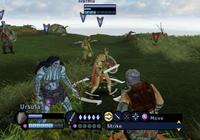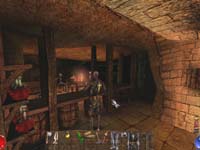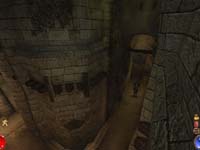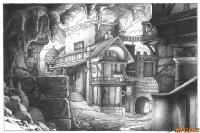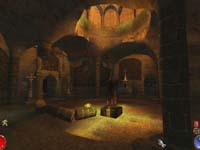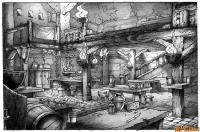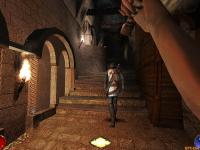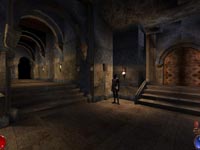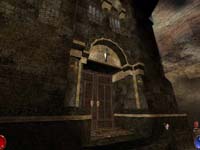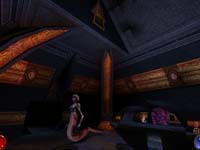|
|
|
Main News Forums Games Games Database Top 100 Release List Support Files Features Reviews Previews Interviews Editorials Diaries Misc Download Gallery Music Screenshots Videos Miscellaneous Staff Members Privacy Statement |
Arx Fatalis Review by Sia 'Garrett' Manzari, 2002-08-01 Trapped in a dungeon, all on your own, no way back and the unknown before you, filled with dangerous perils, lurking beasts, dark secrets and great wonders...those were the ingredients of two of the most succesful and highest acclaimed Computer RPGs of all time. I am talking about Ultima Underworld parts 1 and 2, of course. Since then, and 'then' means since 1993, the Underworld fans have waited for a third installment in the series and now, finally the wait is over! While an official Underworld 3 is more than unlikely, the French company Arkane Studios has ended the wait of a decade with Arx Fatalis, a game the developers themselves consider to be the unofficial Underworld sequel. But can Arx Fatalis live up to its spiritual father? The Story of Exosta Our story takes place on the planet of Exosta, in the city of Arx, to be more specific. And to be even more specific, it doesn't take place in Arx, but below it. This is because the people had to leave the surface of Exosta after the sun has faded away years ago and have settled in the underground, into an old dwarven mine, where each race was given a level of its own and so the caves are inhabited by humans of course, by goblins and trolls, by some kind of snake women called the Sisters of Edurneum, by Ratmen and by a lot of other beings, like dogs, rats, chicken, but also many unfriendly beasts as well.
After the intro movie you generate your playing character, which, despite its 4 attributes strength, intelligence, dexterity and constitution and its 9 skills, including e.g. Close Combat, Ranged Combat, Defense, Magic, Sneaking or Object Lore is not too complex, but leaves enough room to customize the hero (only a hero is available, no heroine, and you can choose among 4 faces for your alter ego) before the game actually begins: You wake up in a goblin prison cell and have no memory, who or where you are. Kultar, the fellow prisoner, gives you the name of Am Shaegar for now, which means something like 'The Nameless' and helps you to escape the prison cell. The escape leads to the first encounter already in which you fight a goblin guard with a bone, since there is no other weapon of use yet.
Combat is done with your mouse: You hold down the left mouse button, and the longer you hold it, the harder you hit with one of the three standard types of attacks, namely slash, swing and thrust. The above mentioned goblin is not too hard to overcome and has some nice goodies with him, as you can search almost every dead enemy for his inventory. The next encounters are rats and spiders, before you come back for more goblin encounters. And it is now, that the excellent NPC AI unfolds: Goblins in the prison guard patrol several hallways and rooms and if they hear you, they stop and look for you or whatever made the noise. And if it comes to combat, they call for help and other goblins come really running to assist them. Or, if you hit them too hard, they run away to get help and are really actually coming back and are looking for you - this is something I have never before witnessed in any computer game and totally amazing!
On the downside regarding AI, some NPC get stuck in objects or keep walking towards a wall for ages; but this happens very, very rarely (actually only one guard did this in my game).
Magic is based on runes you will find along your journey though Arx Fatalis. There are 20 runes, each with a different meaning, for example a magic arrow ist the combination of the runes Aam Taar, where Aam means 'Create' and Taar means 'Bolt'. Altogether, the manual reveals 10 circles of magic spells with 4 spells each, but the inventive player will find some more spell combinations, one of which is extremely powerful...
Items in Arx Fatalis can break and need repair, which decreases their overall durability, if your repair skill is too low - therefore having items repaired at the armourer is recommendable in the beginning.
You can also enchant items or merge them into something new, for example, when you want to bake bread or a cake you mix flour with water and put the dough in the oven, add apples and you have a cake or add poison and you have a poisoned cake, which also impacts NPCs, if they eat it. You can also mix potions, if your skill is high enough, where you need different flowers for different potions, which regenrate life or mana, make ou invisible, or heal poison.
Closely related to object interaction in character interaction, which is merely done by clicking on characters, which opens dialogues, but leaves no multiple choice answers, which is a pity and would add to gameplay a lot. You can also use key items on NPCs, which opens a cutscene or dialogue, leads to a fight or a new quest. When you are being assigned a quest or something important happens, it is always recorded in your Journal.
The Journal consits of a character sheet with all the equipped armour and weapons, the current level, the XPs, attributes and skills - here you also distribute new points when you level up. Then we have the spell book, with all the runes you found so far and all the spells you can cast with them. Quests and plot changes are also kept track here, in the journal segment, automatically and there is no real quest log or even a subheader with quests and done quests.
The game offers resolutions from 640x480x16 up to 1600x1200x32, where the latter totally rocks and is still very smooth with a fast machine and a GeForce 3 or 4 Ti. The levels are put in scene extremely beautiful, where the style of the graphics changes from medieval in the city of Arx, via a rough environment in different dungeon levels to somewhat spacey in the Edurneum outpost. The textures are very detailed from the low distant also and add a lot to the atmosphere. Spell effects are state of the art and NPC animations are quite smooth for women or the Sisters of Edurneum or quite rough for trolls or other clumsy animals.
Which brings us to the audio aspect. The sound effects are, I put it directly, the best I have ever heard so far. EAX works great and this adds a major portion of the game's fantastic atmosphere. Your footsteps, for example do change according to the ground and the type of armour you are wearing. Different NPCs and monsters have different footsteps and ambient sound, be it water or wind is realistic as well.
So, I have told you a lot about the game now, but the most important question is: Is it fun to play? In one word: YES!
Everything in Arx Fatalis, beginning with the clever dungeon design, the exciting story or the challenging puzzles makes it the most intelligent RPG these days! If you love sophisticated gameplay (or are an Ultima Underworld Fan), there is no way for you to avoid Arx Fatalis, if not, go ahead and play Diablo or Dungeon Siege, but be sure you will miss something very special.
Rate this title and view comments Game Info Printer Friendly Version |
|||||||||||||||||||||||||||||||||||||||||||||||||||||||
|
All original content of this site is copyrighted by RPGWatch. Copying or reproducing of any part of this site is strictly prohibited. Taking anything from this site without authorisation will be considered stealing and we'll be forced to visit you and jump on your legs until you give it back. |
||




